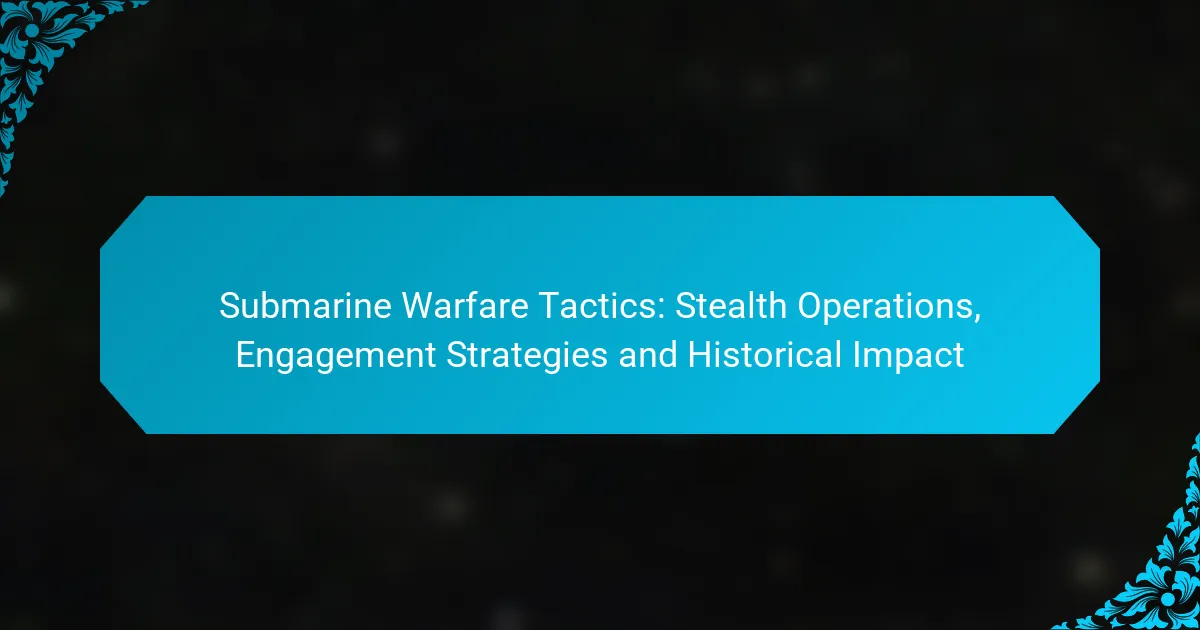Submarine warfare tactics are crucial for modern naval operations, focusing on stealth, engagement strategies, and the historical impact of these methods. By employing advanced technologies for stealth operations, submarines can evade detection and execute surprise attacks. Engagement strategies such as ambush tactics and hit-and-run attacks further enhance their effectiveness, ensuring a significant advantage in naval conflicts.

What Are the Key Submarine Warfare Tactics?
Key submarine warfare tactics encompass stealth operations, engagement strategies, countermeasures, intelligence gathering, and covert infiltration. These tactics are essential for maximizing the effectiveness and survivability of submarines in naval warfare.
Stealth Operations
Stealth operations are critical for submarines, allowing them to evade detection by enemy forces. Techniques such as reducing noise, minimizing sonar reflections, and operating at greater depths enhance stealth capabilities.
Submarines often employ sound-dampening technologies and advanced hull designs to remain undetected. Maintaining a low profile in terms of both noise and visibility is essential for successful stealth operations.
Engagement Strategies
Engagement strategies involve the methods submarines use to attack or defend against enemy vessels. Submarines typically utilize torpedoes and missiles, launching them from concealed positions to maximize surprise and effectiveness.
Choosing the right moment to engage is crucial; submarines often wait for optimal conditions, such as enemy vulnerability or environmental factors that favor stealth. Effective communication and coordination with allied forces enhance engagement success.
Countermeasures
Countermeasures are tactics employed to protect submarines from detection and attack. These include deploying decoys, electronic warfare systems, and utilizing terrain to mask movements.
Submarines may also use advanced sonar jamming techniques to confuse enemy detection systems. Regularly updating countermeasure systems is vital to adapt to evolving threats in submarine warfare.
Intelligence Gathering
Intelligence gathering is a fundamental aspect of submarine operations, enabling commanders to make informed decisions. Submarines collect data on enemy movements, capabilities, and environmental conditions through various sensors and reconnaissance methods.
Utilizing satellite communications and underwater drones can enhance intelligence capabilities. This information is crucial for planning operations and ensuring mission success.
Covert Infiltration
Covert infiltration involves submarines entering enemy waters undetected to gather intelligence or conduct sabotage. This tactic requires precise navigation and timing to avoid detection.
Submarines may deploy special operations forces for missions such as reconnaissance or sabotage, leveraging their stealth to achieve objectives without alerting the enemy. Careful planning and execution are essential to minimize risks during infiltration missions.

How Do Stealth Operations Enhance Submarine Warfare?
Stealth operations significantly enhance submarine warfare by minimizing the likelihood of detection and maximizing the element of surprise. These tactics rely on advanced technologies and techniques to keep submarines hidden from enemy sensors while allowing them to engage effectively.
Reduced Detection Risk
Reduced detection risk is crucial for the success of submarine missions. By operating at greater depths and utilizing natural underwater features, submarines can evade sonar and radar systems. Additionally, maintaining a low profile and minimizing noise emissions are essential strategies for avoiding detection.
Submarines often employ tactics such as staying close to the seabed or using underwater topography to shield themselves from enemy surveillance. This approach can significantly lower the chances of being spotted by surface ships or aircraft.
Advanced Sonar Technology
Advanced sonar technology plays a vital role in enhancing stealth operations. Modern submarines are equipped with sophisticated sonar systems that can detect enemy vessels while remaining undetected themselves. These systems utilize a combination of passive and active sonar to gather intelligence without revealing the submarine’s position.
Passive sonar systems listen for sounds made by other vessels, allowing submarines to track targets without emitting signals. This capability is crucial for stealthy operations, as it helps submarines avoid detection while gathering valuable information about enemy movements.
Silent Running Techniques
Silent running techniques are employed to minimize noise and vibrations produced by submarines. By reducing engine power and shutting down non-essential systems, submarines can operate more quietly, making it difficult for enemy sensors to detect them. This tactic is particularly important during critical phases of a mission, such as evasion or engagement.
Submarines may also adjust their speed and maneuvering patterns to further decrease noise levels. For instance, operating at lower speeds can significantly reduce the acoustic signature, enhancing stealth and increasing the likelihood of successful operations.

What Engagement Strategies Are Commonly Used?
Common engagement strategies in submarine warfare include ambush tactics, hit-and-run attacks, and coordinated strikes. These methods leverage stealth and surprise to maximize effectiveness while minimizing risk.
Ambush Tactics
Ambush tactics involve positioning submarines in strategic locations to surprise enemy vessels. This often requires detailed reconnaissance to identify high-traffic maritime routes or predictable patterns in naval operations.
Submarines can utilize natural underwater terrain, such as canyons or ridges, to conceal their presence. The goal is to strike when the enemy is least prepared, often using torpedoes or missiles from a hidden position.
Hit-and-Run Attacks
Hit-and-run attacks focus on quick strikes followed by immediate withdrawal. Submarines engage enemy ships or installations, deliver their payload, and then retreat to safety before the enemy can effectively respond.
This strategy is particularly effective against larger fleets or when operating in contested waters. Submarines must maintain high operational tempo and have efficient escape routes planned to avoid counterattacks.
Coordinated Strikes
Coordinated strikes involve multiple submarines working together to target a common enemy. This strategy enhances the chances of success by overwhelming the target with simultaneous attacks from different directions.
Effective communication and timing are crucial for coordinated strikes, often requiring advanced technology for real-time data sharing. This method can significantly disrupt enemy operations and create confusion, making it harder for them to mount a defense.

What Historical Impacts Have Submarine Tactics Had?
Submarine tactics have significantly influenced naval warfare throughout history, altering engagement strategies and military outcomes. Their stealth capabilities and ability to disrupt supply lines have reshaped naval doctrines and geopolitical landscapes.
World War I Submarine Warfare
During World War I, submarines, particularly German U-boats, revolutionized naval combat by employing unrestricted submarine warfare. This tactic involved attacking enemy merchant ships without warning, aiming to cut off supplies to Allied forces.
The impact was profound, leading to significant losses for the Allies and prompting changes in naval strategies, including the development of convoy systems to protect merchant vessels. The psychological effect of submarine warfare also contributed to shifting public opinion and wartime policies.
World War II U-Boat Campaigns
In World War II, U-boats played a critical role in the Battle of the Atlantic, targeting Allied shipping routes. The German Navy’s strategy focused on massed attacks against convoys, using wolf pack tactics to overwhelm defenses.
The introduction of advanced technologies, such as sonar and depth charges, eventually countered U-boat effectiveness. However, the initial success of these submarines demonstrated the strategic importance of stealth and surprise in naval engagements.
Cold War Naval Strategies
During the Cold War, submarine tactics evolved with the advent of nuclear-powered submarines, which allowed for prolonged underwater operations and enhanced deterrence capabilities. The focus shifted to stealth and the ability to launch nuclear missiles, fundamentally changing naval warfare dynamics.
Both the United States and the Soviet Union invested heavily in submarine technology, leading to a complex arms race. The strategic implications of these capabilities influenced military planning and international relations, highlighting the importance of submarines in modern warfare.

What Are the Current Trends in Submarine Warfare?
Current trends in submarine warfare emphasize advanced stealth capabilities, integration of emerging technologies, and adaptation to cyber warfare. These developments are reshaping engagement strategies and influencing international naval policies.
Emerging Technologies
Emerging technologies in submarine warfare include advancements in sonar systems, unmanned underwater vehicles (UUVs), and artificial intelligence (AI). These innovations enhance detection capabilities and decision-making processes, allowing submarines to operate more effectively in contested environments.
For example, modern submarines are increasingly equipped with advanced stealth materials and designs that reduce their acoustic signatures, making them harder to detect. Additionally, the use of AI can improve threat assessment and operational efficiency, enabling submarines to respond quickly to changing conditions.
Cyber Warfare Integration
Cyber warfare integration is becoming a critical aspect of submarine operations, as submarines are now vulnerable to cyber attacks that can compromise their systems. Protecting against these threats requires robust cybersecurity measures and continuous monitoring of potential vulnerabilities.
Submarines may also leverage cyber capabilities to disrupt enemy communications and navigation systems, providing a tactical advantage. Training crews in cybersecurity protocols is essential to ensure that submarines can operate securely in a digital battlefield.
International Naval Treaties
International naval treaties play a significant role in shaping submarine warfare strategies and capabilities. Agreements such as the Treaty on the Non-Proliferation of Nuclear Weapons (NPT) and various arms control treaties influence the development and deployment of submarines worldwide.
Compliance with these treaties often requires nations to limit their submarine capabilities or share information about their fleets. Understanding these regulations is crucial for naval strategists to navigate the geopolitical landscape and maintain a balance of power in maritime operations.



